关于我国餐饮业市场现状的翻译
小语种导游面试题目(3篇)

第1篇一、基本素质测试1. 请用您所掌握的小语种,自编一个简短的自我介绍,时间不超过3分钟。
2. 请谈谈您对导游工作的理解,以及为什么选择成为小语种导游。
3. 您认为作为一名小语种导游,应具备哪些基本素质?4. 您如何处理与游客之间的矛盾和冲突?5. 请举例说明您在面对突发事件时,如何保持冷静,妥善处理。
6. 您如何看待团队协作,以及如何与团队成员共同完成任务?7. 请谈谈您如何利用您的语言优势,为游客提供更好的服务。
8. 您认为作为一名小语种导游,应该如何提升自己的综合素质?二、专业知识测试1. 请用您所掌握的小语种,翻译以下中文句子:(1)我国是世界上历史悠久、文化灿烂的国家,拥有丰富的旅游资源。
(2)作为一名导游,您需要具备丰富的历史、地理、文化等知识。
2. 请列举您熟悉的小语种国家或地区,并简要介绍其特色旅游资源和历史文化。
3. 请谈谈您对我国旅游市场的现状及发展趋势的看法。
4. 请列举您认为在小语种导游工作中,最重要的几项专业知识。
5. 请简要介绍您熟悉的小语种国家的签证政策、入境手续等。
6. 请谈谈您如何为游客提供个性化、差异化的旅游服务。
7. 请举例说明您在实际工作中,如何运用专业知识解决游客的疑问。
8. 请谈谈您如何根据游客的需求,设计旅游线路和活动。
三、实际操作测试1. 请模拟一个场景,用您所掌握的小语种,向游客介绍一个旅游景点。
2. 请根据以下材料,用您所掌握的小语种,编写一段导游词:(1)景点名称:故宫(2)景点简介:故宫是中国明清两代的皇宫,也是世界上现存规模最大、保存最为完整的木质结构古建筑之一。
(3)景点特色:故宫的建筑布局严谨,气势恢宏,具有极高的历史、艺术和科学价值。
3. 请根据以下材料,用您所掌握的小语种,回答游客的提问:(1)游客提问:请问故宫的门票价格是多少?(2)游客提问:故宫内有哪些著名的景点?4. 请根据以下材料,用您所掌握的小语种,为游客提供餐饮、住宿等方面的建议:(1)游客提问:请问附近有哪些好的餐馆?(2)游客提问:请问附近有哪些酒店?5. 请根据以下材料,用您所掌握的小语种,回答游客关于当地风俗习惯的提问:(1)游客提问:请问当地有哪些禁忌?(2)游客提问:请问当地有哪些特色美食?四、综合素质测试1. 请谈谈您如何处理工作中的压力和挫折。
关于中国快餐发展行业的英文作文

关于中国快餐发展行业的英文作文The Rise of Fast Food in ChinaHi there! Do you like hamburgers, fries, and chicken nuggets? If so, then you're a fan of fast food, just like many kids and adults all over China. Fast food restaurants have been spreading quickly across the country in recent years, and they're super popular! Let me tell you all about the rise of fast food in China.Not too long ago, there weren't many fast food chains in China. Traditional Chinese food from little restaurant shops and street vendors was the norm. But in the late 1980s, things started to change. Kentucky Fried Chicken (KFC) became the first major American fast food brand to open restaurants in China. The first KFC opened in Beijing in 1987.At first, some people were unsure about this strange "Western" food. Would Chinese people really want to eat fried chicken, burgers, and fries instead of dishes like dumplings, noodles, and stir-fries? As it turned out, the answer was a resounding "Yes!" KFC was a major hit, especially among younger people eager to try this exciting new dining experience.McDonald's arrived on the scene a few years later in 1990, also opening its first restaurant in Beijing. Just like KFC,McDonald's was an instant smash. People loved the Golden Arches, the Big Macs, and those world-famous French fries. More American chains like Pizza Hut followed closely behind in the early 90s.The growth of fast food in China was just getting started. As the economy boomed and living standards rose, more and more Chinese people had money to spend on affordable fast food meals. These restaurants were convenient, delicious, and represented a taste of modern Western culture that many Chinese consumers craved.Not to be outdone, Chinese homegrown fast food brands started popping up as well. Companies like Real Kung Fu borrowed recipes and cooking techniques from ancient Chinese traditions, but presented them in a modern fast food style that appealed to youth. Dico's originated in Taiwan, bringing tasty fried chicken and burgers with an Asian flair.Today, you can find all sorts of fast food joints on nearly every street corner in China's major cities. From Beijing to Shanghai, Guangzhou to Chengdu, the fast food landscape is absolutely booming. Western brands like KFC, McDonald's, Burger King, and many more dot the urban landscape. At thesame time, Chinese companies like Kung Fu and Dico's continue to grow rapidly too.The Chinese fast food market has become so huge that restaurant chains all over the world want a piece of the action. You can now find big brands like Subway, Dairy Queen, Carl's Jr., and even Russian kebab chain Doner Kebab House jostling for space in shopping malls and on busy streets.While fast food is undeniably popular, not everyone is a fan. Some people worry that it's not healthy, with too many calories, salt, sugar, and fat. They argue that traditional Chinese cuisine is much more nutritious and balanced. The booming fast food sector has also raised concerns about food safety at times, with some outlets getting in trouble for using expired ingredients or poor hygiene practices.Still, millions upon millions of Chinese people clearly can't get enough of fried chicken sandwiches, cheeseburgers, french fries, milkshakes, and all the other greasy, tasty, addictive fast food goodies. When you're a busy student or office worker in a rushed modern society, sometimes you just want a super convenient, affordable, and yummy meal after a stressful day.So whether you consider fast food to be a blessing or a curse for public health, there's no denying its soaring popularity acrossChina. Next time you're strolling around Shanghai and you get a whiff of sizzling beef patties on the grill at the local Mickey D's, just remember - it's all part of China's blazing hot fast food revolution!。
中国传统美食的英译现状及对策——以风味小吃为例
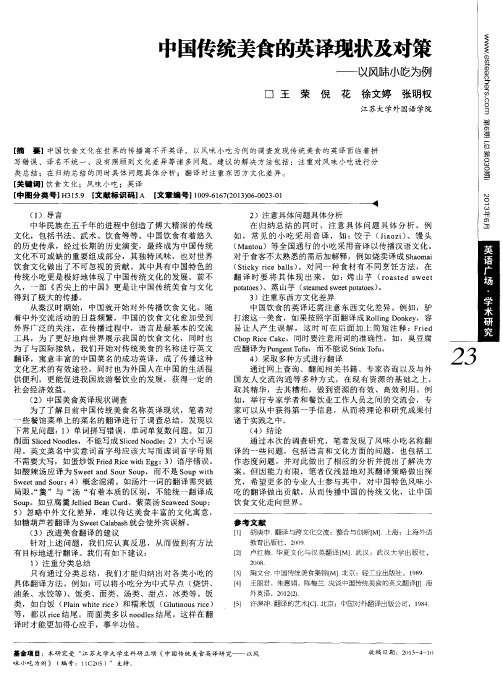
3 )注 重 东 西方 文化 差异 中 国饮 食 的 英 译 还 需 注 意 东 西 文 化 差 异 。 例 如 ,驴 打滚这 一美食,如果按照字面翻译 成 R o l l i n g D o n k e y , 容 易 让 人 产 生 误 解 , 这 时 可 在 后 面 加 上 简 短 注 释 :F r i e d C h o p R i c e C a k e 。同时要注意用词 的准确性 ,如 ,臭豆腐 应翻译为 P u n g e n t T o f u ,而 不 能 说 S t i n k T o f u 。 4 )采取多种方式进 行翻 译 通 过 网 上 查 询 、 翻 阅相 关 书 籍 、 专 家 咨 询 以及 与 外 国 友 人 交 流 沟 通 等 多种 方 式 , 在 现 有 资 源 的基 础 之 上 , 取其精 华 ,去其 糟粕 ,做 到资源 的有 效、高效利用 。例 如 ,举 行专家 学者和餐饮业 工作人员之 间的交流会 ,专 家 可 以 从 中获 得 第 一 手 信 息 , 从 而 将 理 论 和 研 究 成 果付 诸 于实 践之 中 。 ( 4 )结 论 通 过本次 的调 查研究 ,笔者发现 了风 味小吃名称翻 译 的 一 些 问题 , 包 括 语 言和 文 化 方 面 的 问 题 ,也 包 括 工 作 态 度 问题 , 并 对 此 做 出 了 相 应 的分 析 并 提 出 了解 决 方 案 。但 因能 力 有 限 ,笔 者 仅 浅 显 地 对 其翻 译 策 略 做 出探 究 , 希 望 更 多 的 专 业 人 士 参 与 其 中 ,对 中 国 特 色 风 味 小 吃 的翻译做 出贡献 ,从而传 播中 国的传统文化 ,让 中国 饮 食 文 化 走 向世 界 。
哆啦a梦卡通ppt模版16页PPT
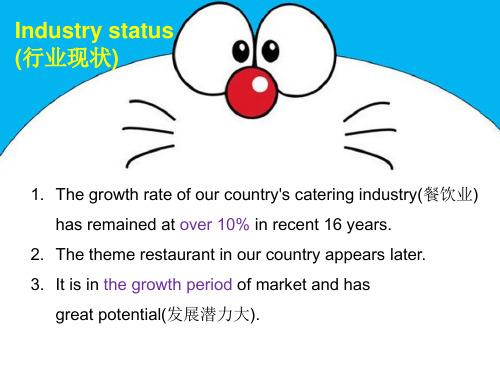
The Introduction of Restaurant
A. Basic situation. B. Loction. C. the internal environment D. Service concept E. Operational advantages and competitiveness G. Segment the market
2.People can be relax.
3.Meet some special psychological needs of customers.
•Segment the market
2020/4/28
2020/4/28
SERVICE PROCESS
I. The customers coming II. Waiting process III.Dining process IV. The customer leaving
The customers coming
Serving them immediately with smile.
Waiting process
If there were no enough empty tables for customers, we would lead them to our waiting room.
Basic situation
Organization
Fund investment
Main business content
(主营业务范围)
Echo 100million Catering(餐饮)
Choose DORAEMON’s Reasons
1.Make people satisfy customers’ appetites.
餐饮行业文言文翻译
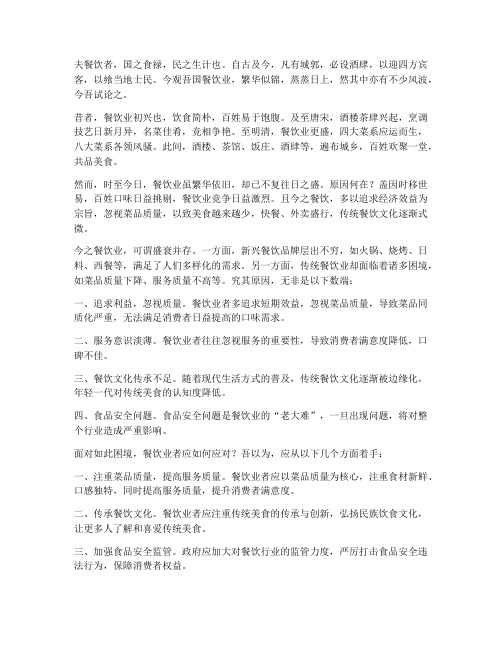
夫餐饮者,国之食禄,民之生计也。
自古及今,凡有城郭,必设酒肆,以迎四方宾客,以飨当地士民。
今观吾国餐饮业,繁华似锦,蒸蒸日上,然其中亦有不少风波,今吾试论之。
昔者,餐饮业初兴也,饮食简朴,百姓易于饱腹。
及至唐宋,酒楼茶肆兴起,烹调技艺日新月异,名菜佳肴,竞相争艳。
至明清,餐饮业更盛,四大菜系应运而生,八大菜系各领风骚。
此间,酒楼、茶馆、饭庄、酒肆等,遍布城乡,百姓欢聚一堂,共品美食。
然而,时至今日,餐饮业虽繁华依旧,却已不复往日之盛。
原因何在?盖因时移世易,百姓口味日益挑剔,餐饮业竞争日益激烈。
且今之餐饮,多以追求经济效益为宗旨,忽视菜品质量,以致美食越来越少,快餐、外卖盛行,传统餐饮文化逐渐式微。
今之餐饮业,可谓盛衰并存。
一方面,新兴餐饮品牌层出不穷,如火锅、烧烤、日料、西餐等,满足了人们多样化的需求。
另一方面,传统餐饮业却面临着诸多困境,如菜品质量下降、服务质量不高等。
究其原因,无非是以下数端:一、追求利益,忽视质量。
餐饮业者多追求短期效益,忽视菜品质量,导致菜品同质化严重,无法满足消费者日益提高的口味需求。
二、服务意识淡薄。
餐饮业者往往忽视服务的重要性,导致消费者满意度降低,口碑不佳。
三、餐饮文化传承不足。
随着现代生活方式的普及,传统餐饮文化逐渐被边缘化,年轻一代对传统美食的认知度降低。
四、食品安全问题。
食品安全问题是餐饮业的“老大难”,一旦出现问题,将对整个行业造成严重影响。
面对如此困境,餐饮业者应如何应对?吾以为,应从以下几个方面着手:一、注重菜品质量,提高服务质量。
餐饮业者应以菜品质量为核心,注重食材新鲜、口感独特,同时提高服务质量,提升消费者满意度。
二、传承餐饮文化。
餐饮业者应注重传统美食的传承与创新,弘扬民族饮食文化,让更多人了解和喜爱传统美食。
三、加强食品安全监管。
政府应加大对餐饮行业的监管力度,严厉打击食品安全违法行为,保障消费者权益。
四、创新经营模式。
餐饮业者应紧跟时代步伐,创新经营模式,如线上线下融合、特色餐饮体验等,以满足消费者多样化的需求。
关于中国快餐业的发展的英语作文
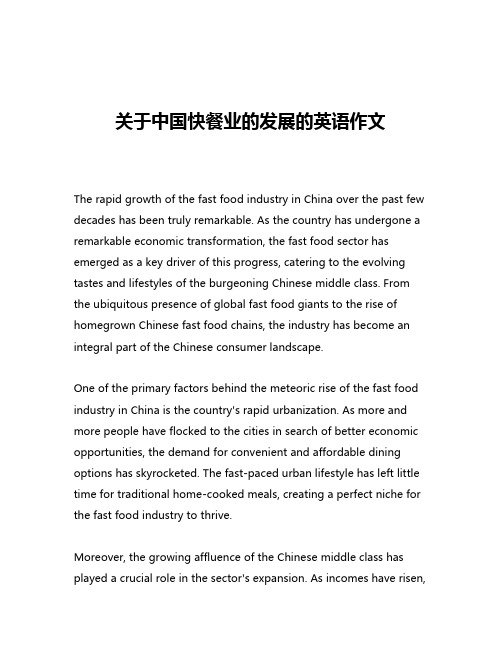
关于中国快餐业的发展的英语作文The rapid growth of the fast food industry in China over the past few decades has been truly remarkable. As the country has undergone a remarkable economic transformation, the fast food sector has emerged as a key driver of this progress, catering to the evolving tastes and lifestyles of the burgeoning Chinese middle class. From the ubiquitous presence of global fast food giants to the rise of homegrown Chinese fast food chains, the industry has become an integral part of the Chinese consumer landscape.One of the primary factors behind the meteoric rise of the fast food industry in China is the country's rapid urbanization. As more and more people have flocked to the cities in search of better economic opportunities, the demand for convenient and affordable dining options has skyrocketed. The fast-paced urban lifestyle has left little time for traditional home-cooked meals, creating a perfect niche for the fast food industry to thrive.Moreover, the growing affluence of the Chinese middle class has played a crucial role in the sector's expansion. As incomes have risen,consumers have become more willing to spend on dining out, and the fast food industry has been quick to capitalize on this trend. The introduction of global fast food giants, such as McDonald's, KFC, and Starbucks, has not only catered to this growing demand but has also helped to shape the dining preferences of the Chinese consumer.Interestingly, the fast food industry in China has also undergone a process of localization, with many homegrown chains emerging to cater to the unique tastes and preferences of the Chinese market. These chains have been able to adapt their menus and offerings to better suit the local palate, often incorporating traditional Chinese ingredients and flavors into their dishes. This localization has been a key factor in the success of these domestic fast food chains, as they have been able to appeal to the patriotic sentiments of Chinese consumers.Another important aspect of the fast food industry's growth in China has been the increasing emphasis on innovation and diversification. As the market has become more saturated, fast food chains have had to find new ways to stay ahead of the competition. This has led to the introduction of a wide range of new menu items, from fusion dishes that blend Chinese and Western flavors to the incorporation of cutting-edge food technology, such as plant-based meat alternatives.The rise of the delivery and online ordering platforms has also been a game-changer for the fast food industry in China. With the widespread adoption of smartphones and the increasing popularity of food delivery apps, consumers have become accustomed to the convenience of having their favorite fast food items delivered right to their doorsteps. This has not only made it easier for consumers to access fast food but has also opened up new avenues for fast food chains to reach a wider customer base.Despite the industry's impressive growth, the fast food sector in China is not without its challenges. One of the primary concerns is the issue of health and nutrition. As the consumption of fast food has become more widespread, there have been growing concerns about the impact on public health, with issues such as obesity, diabetes, and heart disease becoming more prevalent. In response to these concerns, many fast food chains have begun to introduce healthier menu options and to emphasize the importance of balanced and nutritious meals.Another challenge facing the fast food industry in China is the increasing competition from other dining options, such as the rise of the "new retail" concept, which combines traditional brick-and-mortar stores with e-commerce and digital technologies. These new dining experiences, which often feature a more upscale and experiential approach, have been attracting a growing number ofconsumers, particularly among the younger generations.Despite these challenges, the future of the fast food industry in China remains bright. As the country's economy continues to grow and the middle class expands, the demand for convenient and affordable dining options is likely to remain strong. Moreover, the industry's ability to adapt and innovate will be crucial in ensuring its continued success.In conclusion, the fast food industry in China has undergone a remarkable transformation, evolving from a relatively niche market to a dominant force in the country's dining landscape. The industry's success has been driven by a combination of factors, including the rapid urbanization of the population, the growing affluence of the middle class, and the industry's ability to localize and innovate. While there are certainly challenges ahead, the future of the fast food industry in China looks bright, as it continues to cater to the changing tastes and preferences of the Chinese consumer.。
探讨中国餐饮服务行业的英语表达与市场分析
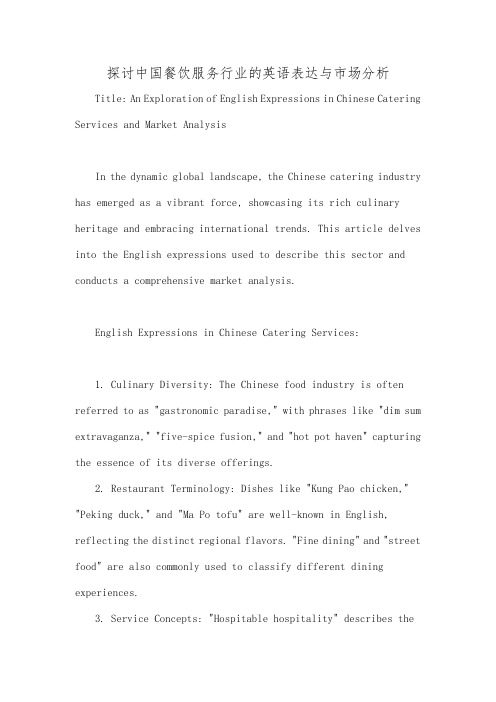
探讨中国餐饮服务行业的英语表达与市场分析Title: An Exploration of English Expressions in Chinese Catering Services and Market AnalysisIn the dynamic global landscape, the Chinese catering industry has emerged as a vibrant force, showcasing its rich culinary heritage and embracing international trends. This article delves into the English expressions used to describe this sector and conducts a comprehensive market analysis.English Expressions in Chinese Catering Services:1. Culinary Diversity: The Chinese food industry is often referred to as "gastronomic paradise," with phrases like "dim sum extravaganza," "five-spice fusion," and "hot pot haven" capturing the essence of its diverse offerings.2. Restaurant Terminology: Dishes like "Kung Pao chicken," "Peking duck," and "Ma Po tofu" are well-known in English, reflecting the distinct regional flavors. "Fine dining" and "street food" are also commonly used to classify different dining experiences.3. Service Concepts: "Hospitable hospitality" describes thewarm and attentive service found in many Chinese restaurants. "Family-style dining" or "group dining" refers to the communal sharing of dishes that's a cultural norm.4. Online Platforms: "Food delivery apps" like Meituan or Dianping play a pivotal role, while "takeout" and "delivery" are essential terms for describing this aspect of the industry.Market Analysis:1. Market Size: China's catering sector is the world's largest, with an estimated value of over 5 trillion in 2021. The rapid urbanization and growing middle class have fueled its expansion.2. Consumer Trends: Health-conscious consumers are driving demand for "organic" and "low-calorie" options, translating to phrases like "green cuisine" and "wellness dining." Technology adoption is another key trend, with "smart kitchens" and "mobile ordering" becoming more prevalent.3. Internationalization: Many Chinese brands, like Haidilao and Din Tai Fung, have gained global recognition, showcasing the industry's globalization through phrases like "global culinary ambassadors" and "cross-cultural fusion."4. Regulatory Environment: The government's emphasis on "safeand hygienic" practices, as reflected by the term "food safety regulations," has become a priority for both domestic and foreign businesses operating in the market.5. Challenges and Opportunities: Despite the growth, the industry faces competition from home-grown startups and international fast-food chains. However, there remain ample opportunities for innovation and differentiation, especially in sustainable catering and personalized dining experiences.In conclusion, understanding the English expressions and market dynamics within the Chinese catering sector is crucial for businesses looking to engage with this massive and evolving market. By adapting to consumer preferences and regulatory requirements, the industry continues to evolve, fostering a unique blend of tradition and modernity in the global culinary scene.中文回答:在中国餐饮服务业中,英语表达既体现了其丰富的美食文化,也反映了市场趋势。
中餐菜单英译的现状、原因及方法初探
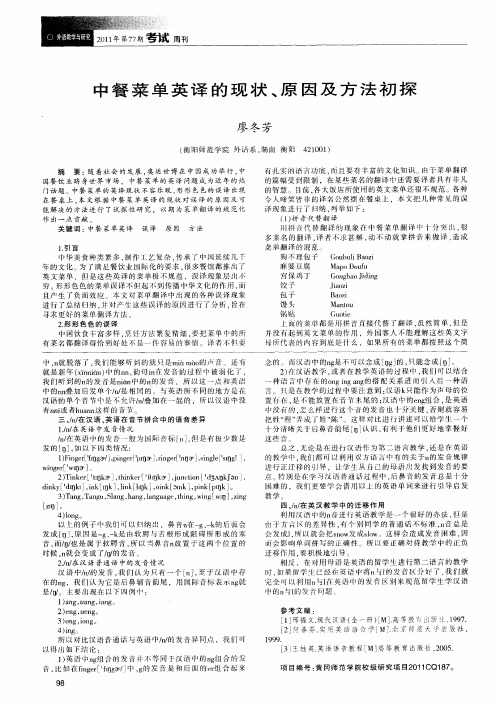
关 键 词 :中餐 菜单 英译 误 译 原 因 方 法
1引 言 .
中 华美 食 种 类 繁 多 , 制作 工 艺 复 杂 , 承 了 巾 删延 续 J 下 传 L 年 的文 化 为 了满 足餐 饮 业 国 际 化 的要 求 , 多餐 馆 都 推 出 了 很 英 文菜 单 ,但 是 这 些 英 译 的菜 单 极 不 规 范 ,误 译现 象 层 { I j 穷 。 形 色 色 的菜 单 误 泽不 但 起 不 到 传 播 中华 文 化 的 作 用 , 形 而 且 产生 了负 面效 应 。本 文 对 菜 单 翻 译 中 出现 的各 种 误 译 现 象 进 行 了 总结 归纳 , 对 产 生 这 些 误 译 的 原 冈 进 行 了 分 析 , 并 旨在 寻 求更 好 的菜 单 翻 泽方 法 。 2形 形 色 色 的 误 译 . 中 国饮 食 丰 富多 样 , 饪 方 法 繁 复 精 细 , 把 菜 单 中 的所 烹 要 有 菜 名都 翻译 得 恰 到 好 处 不 是 一 件 容 易 的事 情 。 译者 仍 要 中 ,就 脱 落 了 , n 我们 能 够 听 到 的 就 只 是mi nm的 卢 音 还 有 af 就 是 新 年 (ind ) 的n , 母 i 任 发 音 的 过 程 中被 弱化 丁 , xn in 巾 n韵 n 我 们 昕 到 的n 的发 音 是 nd 中 的n in 的发 音 。所 以 这 点 和 英 语 中 的n 叠加 后 发 单 个// 相 同 的 。 与英 语 所 不 同 的地 方 是 n n是 汉 语 的 单个 音 节 中是 允 许 , 叠 加 在 一 起 的 ,所 以汉 语 中没 n , 有n i 者 h a n n或 u n 这样 的 音节 三 、 / 汉 语 、 语在 音 节 拼 合 中 的 语 音 差异 /在 n 英 1// 英语 中发 音 情 况 . 在 n // 英 语 中 的发 音 一般 为 国际 青 标 f ] 但 是 有 救 少 数 是 n在 n , 发 的 f ]如 以下 四类 情 况 : n, 1Fn e[ de ] igrpl ]r gr。J ̄,nl[ig _ )igrr g /, n e[ l ̄ ,n e[i ] ig ‘D !l 。 i p 。3 i r o s es I
翻译硕士CATTI笔译常用词汇分类农业

翻译硕士CATTI笔译常用词汇分类:农业保护耕地protectarableland病虫害防治pestanddiseasecontrol播种面积sownarea“菜篮子”工程theVegetableBasketProject餐饮业cateringtrade产业化扶贫reducepovertythroughindustrialdevelopment城乡低保urbanandruralrecipientsofsubsistenceallowances 单位面积产量yieldperunitarea滴灌dripirrigation动植物检疫animalandplantquarantine扶贫povertyalleviation/anti-povertyeffort扶贫政策povertyreliefpolicy复种multiplecropping副产品by-products副业sidelineproduction改良土壤soilimprovement耕地保护制度systemforprotectingarableland耕作设施farmingequipment灌溉面积irrigatedarea国家收购粮grainpurchasedbythestate旱地arid/non-irrigatedland洪涝灾害floodandwaterlogging集体林权制度改革reformofthesystemofcollectiveforestrights集约/粗放型农业intensive/extensiveagriculture加强农产品市场调控strengthenregulationofthefarmproductsmarket 减免农业税reduceandexempttheagriculturaltax减轻农民负担lightentheburdenonthepeasants建设高标准农田developfarmplotsthatmeethighstandards节约用地制度systemforeconomizingontheuseofland经济作物cashcrops开垦荒地reclaimwasteland抗病/虫/旱性disease-/pest-/drought-resistant科教兴农invigorateagriculturebyrelyingonscienceandeducation 联合国粮食与农业组织theUNFoodandAgricultureOrganizationFAO良种补贴subsidiesforsuperiorcropvarieties粮食安全foodsecurity粮食产业建设项目projectsforindustrializinggrainproduction粮食储备grainreserves粮食品种grainvarieties粮食直补directsubsidiestograinproducers粮食综合生产能力overallgrainproductioncapacity粮食最低收购价minimumgrainpurchasingprices粮食作物cerealcrops绿色革命GreenRevolution绿色食品greenfood绿色证书greencertificate苗圃seedlingnursery民工潮farmer’sfrenziedhuntforworkincities奶制品dairyproduct内陆水域inlandwaters农产品精深加工和销售intensiveprocessingandsaleofagriculturalproducts农产品质量监管monitorthequalityofagriculturalproducts 农村公益事业性建设项目ruralpublicfacilities农村集市ruralfair农村居民人均纯收入ruralpercapitanetincome农村民生工程projectsdesignedtoimprovethelivesofruralresidents 农村综合改革comprehensivereformsinruralareas农机具购置补贴subsidiesforthepurchaseofagriculturalmachineryandtools农林牧副渔全面发展all-rounddevelopmentof/infarming,forestry,animal,sidelineproduc tionandfishery农贸市场farmproducemarket农民的积极性farmers’enthusiasm农民工ruralmigrantworkers农民专业合作社specializedfarmercooperatives农田水利化bringlandunderirrigation农田水利建设constructionofwaterconservancyworks农业基础设施agriculturalinfrastructure农业技术agriculturaltechnology农业科技创新成果推广expandapplicationofinnovationsinagriculturalscienceandtechnolog y农业科技投入spendonagriculturalscienceandtechnology农用物资farminputs农资综合补贴generalsubsidiesforagriculturalproductionsupplies 喷灌sprinklerirrigation人均占有量percapitaavailability“三农”agriculture,ruralareasandfarmers社会主义新农村SocialistNewCountryside收购价purchasingprice薯类作物tubercrops水产品aquaticproduct水产业aquaticproductsindustry;fishery水稻田paddyfield水利设施waterconservancyfacilities水土保持waterandsoilconservation水土流失soilerosion太空育种spacebreeding糖料作物sugar-bearingcrops特色现代农业modernagriculturewithdistinctivelocalfeatures梯田terracedfield土地承包经营权流转transferoflanduserights土壤肥力soilfertility脱贫shakeoffpoverty温饱型企业subsistenceagriculture沃地fertileland消费信贷consumercredit小城镇建设developmentofsmalltowns小额信贷microcredit;microloan;microlending兴修水利undertakewaterconservancyprojects畜牧业animalhusbandry遗传学研究geneticresearch议价粮grainsoldatanegotiatedprice优化品种结构optimizethevarietymix油料作物oil-bearingcrops有机肥organicfertilizer中国人口的70%多是农民.Morethan70percentofChina’spopulationisfarmers.推进社会主义新农村建设,我们必须把重点放在发展农村经济,增加农民收入上.Topromotetheconstructionofanewsocialistcountryside,wemustfocuso ndevelopingtheruraleconomyandincreasingfarmers’incomes.发展现代农业,推进新农村建设,我们要靠政策、靠投入、靠科技、靠改革. Wemustdevelopmodernagricultureandpromotethebuildingofanewcountr ysidethroughgovernmentpolicy,funding,applicationofscienceandtec hnologyandreform.农业、农村和农民问题,是关系全面建设小康社会和现代化事业全局的重大问题.Theissuesrelatedtoagriculture,ruralareasandfarmershaveamajorimp actonbuildingamoderatelyprosperoussocietyinallrespectsandonthem odernizationdrive.坚持稳定和完善农村基本经营制度,坚持因地制宜,从实际出发,坚持尊重农民意愿,维护农民权益,反对形式主义和强迫命令. Wewillcontinuetostabilizeandimprovethebasicsystemforruraloperat ionsandcontinuetotailormeasurestosuitlocalconditions,proceedfro mthereality,respectthewishesoffarmers,safeguardtheirrightsandin terests,andopposeformalismcoercionandcommandism.我们要巩固和加强农业基础地位,促进农业稳定发展和农民持续增收.Wewillconsolidateandstrengthenthepositionofagricultureasthefoun dationoftheeconomy,promotingsteadydevelopmentofagricultureandco ntinuousincreaseinfarmer’sincomes.我们要切实稳定种植面积,着力提高单产,优化品种结构,推进全国新增粮食生产能力建设. Wewilleffectivelykeeptheareaplantedwithgraincropsstable,focuson increasingtheyieldperunitareaandoptimizingthevarietymix,andincr easethecountry’sgrainproductioncapacity.我们要以市场需求为导向调整农业结构. Wewilladjusttheagriculturalstructurebasedonmarketdemand.我们要多渠道促进农民增收.Wewillincreasefarmer s’incomesinavarietyofways.我们要加大扶贫开发力度. Wewillintensifyoureffortstoalleviatepovertythroughdevelopment.我们要较大幅度提高粮食最低收购价,保持农产品价格合理水平,提高种粮农民积极性. Wewillsignificantlyraiseminimumgrainpurchasingpricesandkeepthep ricesofagriculturalproductsatareasonableleveltoencouragefarmers togrowmore.我们要现有土地承包关系要保持稳定并长久不变,赋予农民包括离乡农民工更加充分而有保障的土地承包经营权.Wewillensurethatexistinglandcontractrelationshipsremainstablean dunchangedforalongtimetocomeandallowfarmers,includingmigrantwor kerswholeavetheirhomevillages,toenjoytheirfullandguaranteedrigh tstocontractandmanageland.土地承包经营权流转必须坚持依法自愿有偿的原则. Thetransferoflanduserightsmustproceedonthebasisofvoluntaryparti cipationandcompensationandinaccordancewiththelaw.我们要启动新一轮农村电网改造,扩大农村沼气建设规模. Wewillbeginanewroundoftheupgradingofruralpowergridsandbuildmore ruralmethanefacilities.我们要着力提高城镇综合承载能力,发挥城市对农村的辐射带动作用,促进城镇化和新农村建设良性互动. Wewillincreasetheoverallcarryingcapacityofcitiesandtowns,ensure thaturbanareasstimulatethedevelopmentofsurroundingruralareas,an dpromotepositiveinteractionbetweenurbanizationandthebuildingofa newcountryside.城乡建设都要坚持最严格的耕地保护制度和最严格的节约用地制度,切实保护农民合法权益.Whendevelopingurbanandruralareas,wemustadheretothestrictestsyst emsforprotectingarablelandandeconomizingonlandtoprotectthelegit imaterightsandinterestsoffarmers.我们要大力发展农产品加工业,推进农业产业化经营,支持批发市场和农贸市场升级改造,推动生产与市场对接. Wewilldeveloptheprocessingindustryforagriculturalproducts,promo teindustrializationinagriculture,supportandtheupgradingandrenov ationofmarketsforwholesaleandfarmproduce,andmaintainclosertiesb etweenproductionandthemarket.我们要坚持不懈地消除贫困落后,让农民群众早日过上富裕安康的生活. Wewillworkunremittinglytoeradicatepovertyandbackwardnesssothatr uralresidentscansoonliveaprosperousandhappylife.我们要加强对产粮大县的财政扶持. Wewillincreasefiscalsupportformajorgrain-producingcounties.。
外卖行业的现状和趋势英语作文
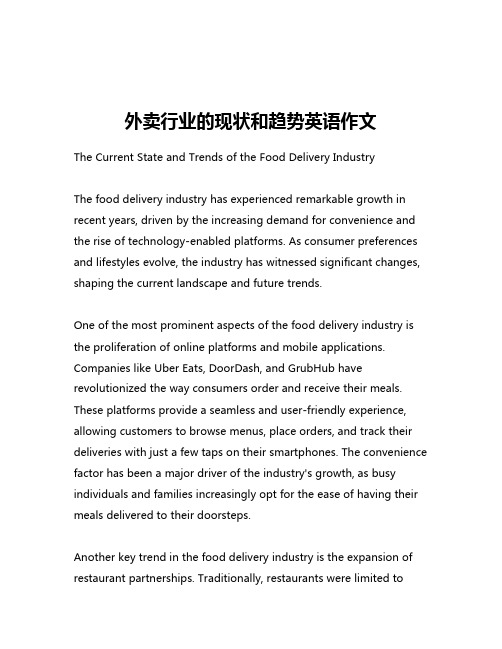
外卖行业的现状和趋势英语作文The Current State and Trends of the Food Delivery IndustryThe food delivery industry has experienced remarkable growth in recent years, driven by the increasing demand for convenience and the rise of technology-enabled platforms. As consumer preferences and lifestyles evolve, the industry has witnessed significant changes, shaping the current landscape and future trends.One of the most prominent aspects of the food delivery industry is the proliferation of online platforms and mobile applications. Companies like Uber Eats, DoorDash, and GrubHub have revolutionized the way consumers order and receive their meals. These platforms provide a seamless and user-friendly experience, allowing customers to browse menus, place orders, and track their deliveries with just a few taps on their smartphones. The convenience factor has been a major driver of the industry's growth, as busy individuals and families increasingly opt for the ease of having their meals delivered to their doorsteps.Another key trend in the food delivery industry is the expansion of restaurant partnerships. Traditionally, restaurants were limited totheir own in-house delivery services or local courier services. However, the emergence of third-party delivery platforms has opened up new opportunities for restaurants to reach a wider customer base. By partnering with these platforms, restaurants can leverage the extensive delivery networks and marketing capabilities of the platforms, allowing them to cater to a broader range of customers and potentially increase their sales and revenue.The rise of ghost kitchens, also known as virtual kitchens or cloud kitchens, is another significant development in the industry. These are commercial kitchens that are designed solely for the purpose of preparing food for delivery, without the need for a traditional dine-in establishment. Ghost kitchens offer several advantages, such as reduced overhead costs, the ability to experiment with different cuisines and menu items, and the potential to serve a larger geographic area. This model has gained traction as it allows entrepreneurs and established restaurants to expand their reach and capitalize on the growing demand for food delivery.Sustainability and environmental consciousness have also become increasingly important in the food delivery industry. Consumers are becoming more aware of the impact of their purchasing decisions on the environment, and they are demanding more eco-friendly practices from the companies they support. In response, many food delivery platforms and restaurants are implementing initiatives toreduce their carbon footprint, such as using biodegradable packaging, promoting the use of reusable containers, and encouraging the use of electric or hybrid vehicles for deliveries.The COVID-19 pandemic has further accelerated the growth of the food delivery industry, as lockdowns and social distancing measures have led to a significant increase in demand for contactless delivery services. Consumers who were previously hesitant to order food online have become more comfortable with the process, and many have developed a habit of relying on food delivery as a primary means of obtaining their meals. This shift in consumer behavior is likely to have lasting effects on the industry, as customers continue to value the convenience and safety offered by food delivery platforms even as the pandemic subsides.Looking ahead, the future of the food delivery industry is poised to be shaped by several key trends. Technological advancements, such as the integration of artificial intelligence and machine learning, are expected to improve the efficiency and personalization of delivery services. Predictive analytics and data-driven insights will enable platforms to better understand customer preferences and optimize their operations accordingly. Additionally, the integration of sustainable practices, such as the use of renewable energy and the development of eco-friendly packaging solutions, will become increasingly important as consumers and regulatory bodies demandmore environmentally responsible practices from the industry.Another emerging trend is the potential for consolidation and strategic partnerships within the industry. As the market becomes more competitive, larger players may seek to acquire or merge with smaller competitors, leveraging economies of scale and diversifying their offerings. Additionally, collaborations between food delivery platforms and other sectors, such as grocery stores or retail chains, could result in the creation of integrated delivery ecosystems that provide a more comprehensive range of services to consumers.In conclusion, the food delivery industry is undergoing a period of significant transformation, driven by technological advancements, changing consumer preferences, and growing environmental concerns. The rise of online platforms, the expansion of restaurant partnerships, and the emergence of ghost kitchens have all contributed to the industry's growth and evolution. As the industry continues to adapt to the changing landscape, the future is likely to be characterized by increased efficiency, personalization, and sustainability, ultimately shaping the way consumers access and enjoy their meals.。
关于中国快餐业发展的英语作文
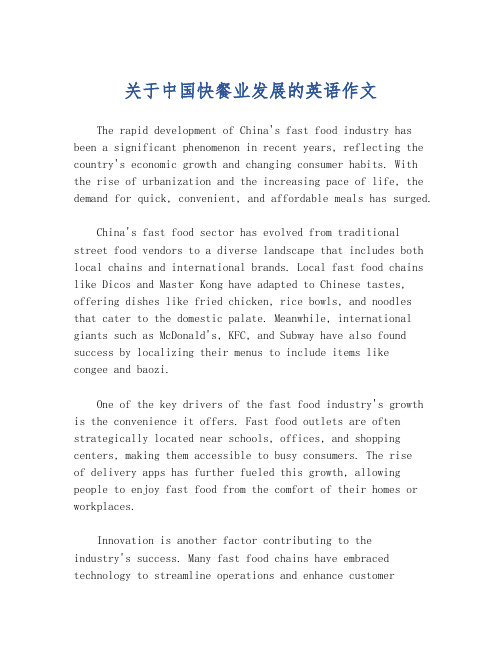
关于中国快餐业发展的英语作文The rapid development of China's fast food industry has been a significant phenomenon in recent years, reflecting the country's economic growth and changing consumer habits. With the rise of urbanization and the increasing pace of life, the demand for quick, convenient, and affordable meals has surged.China's fast food sector has evolved from traditional street food vendors to a diverse landscape that includes both local chains and international brands. Local fast food chains like Dicos and Master Kong have adapted to Chinese tastes, offering dishes like fried chicken, rice bowls, and noodles that cater to the domestic palate. Meanwhile, international giants such as McDonald's, KFC, and Subway have also found success by localizing their menus to include items likecongee and baozi.One of the key drivers of the fast food industry's growth is the convenience it offers. Fast food outlets are often strategically located near schools, offices, and shopping centers, making them accessible to busy consumers. The riseof delivery apps has further fueled this growth, allowing people to enjoy fast food from the comfort of their homes or workplaces.Innovation is another factor contributing to theindustry's success. Many fast food chains have embraced technology to streamline operations and enhance customerexperience. Mobile ordering, digital menus, and self-service kiosks are becoming increasingly common, providing a more efficient and personalized dining experience.However, the fast food industry in China also faces challenges. Health concerns have led to a growing awareness of the need for balanced diets and the potential risks associated with consuming too much fast food. As a result, there is a trend towards healthier options, with some chains offering salads, low-fat meals, and vegetarian choices.Environmental sustainability is another area of focus. The use of disposable packaging and the high volume of waste generated by fast food outlets have prompted calls for more eco-friendly practices. Some chains have responded by introducing biodegradable packaging and encouraging customers to bring their own reusable containers.In conclusion, the fast food industry in China isthriving and continues to innovate to meet the evolving needs and preferences of its consumers. While challenges such as health and sustainability remain, the industry's adaptability and commitment to improvement suggest a promising future for fast food in China.。
食品行业现状英语作文
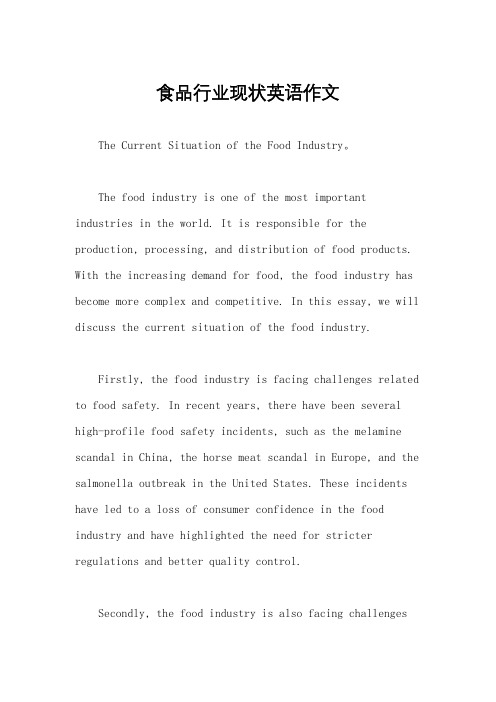
食品行业现状英语作文The Current Situation of the Food Industry。
The food industry is one of the most important industries in the world. It is responsible for the production, processing, and distribution of food products. With the increasing demand for food, the food industry has become more complex and competitive. In this essay, we will discuss the current situation of the food industry.Firstly, the food industry is facing challenges related to food safety. In recent years, there have been several high-profile food safety incidents, such as the melamine scandal in China, the horse meat scandal in Europe, and the salmonella outbreak in the United States. These incidents have led to a loss of consumer confidence in the food industry and have highlighted the need for stricter regulations and better quality control.Secondly, the food industry is also facing challengesrelated to sustainability. With the growing population and increased demand for food, the food industry is under pressure to produce more food while minimizing its impact on the environment. This has led to a focus on sustainable agriculture, which involves using farming practices that are environmentally friendly and socially responsible.Thirdly, the food industry is facing challenges related to innovation. With the increasing competition in the market, food companies are looking for ways todifferentiate themselves from their competitors. This has led to a focus on innovation, with companies investing in research and development to create new products and technologies.Despite these challenges, the food industry is also experiencing growth and opportunities. The global food market is expected to grow at a compound annual growth rate of 4.5% from 2020 to 2025. This growth is driven by factors such as the increasing population, rising incomes, and changing consumer preferences.In conclusion, the food industry is facing challenges related to food safety, sustainability, and innovation. However, it is also experiencing growth and opportunities. To succeed in this industry, companies need to focus on quality control, sustainable agriculture, and innovation. By doing so, they can meet the growing demand for food and ensure the long-term success of their business.。
中国餐饮业利弊英语作文
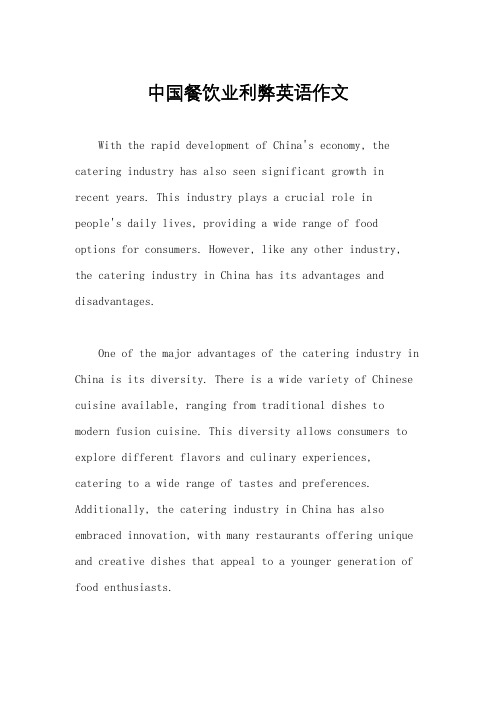
中国餐饮业利弊英语作文With the rapid development of China's economy, the catering industry has also seen significant growth in recent years. This industry plays a crucial role inpeople's daily lives, providing a wide range of food options for consumers. However, like any other industry, the catering industry in China has its advantages and disadvantages.One of the major advantages of the catering industry in China is its diversity. There is a wide variety of Chinese cuisine available, ranging from traditional dishes to modern fusion cuisine. This diversity allows consumers to explore different flavors and culinary experiences, catering to a wide range of tastes and preferences. Additionally, the catering industry in China has also embraced innovation, with many restaurants offering unique and creative dishes that appeal to a younger generation of food enthusiasts.Another advantage of the catering industry in China is its contribution to the economy. The industry employs millions of people, from chefs and waitstaff to suppliers and distributors. This creates jobs and stimulates economic growth, benefiting both urban and rural communities. Additionally, the catering industry also attracts tourists from around the world, boosting the country's tourism sector and generating revenue for local businesses.Despite its many advantages, the catering industry in China also faces several challenges. One of the major disadvantages is food safety concerns. In recent years, there have been several high-profile cases of food contamination and safety violations in China, leading to public health scares and consumer distrust. This has had a negative impact on the reputation of the catering industry and has raised questions about the quality and safety of the food being served.Another disadvantage of the catering industry in China is its environmental impact. The industry is a major contributor to food waste and pollution, with large amountsof food being thrown away each day and packaging waste piling up in landfills. This not only harms the environment but also contributes to global warming and other environmental issues. In recent years, there has been a growing awareness of the need for sustainable practices in the catering industry, but more needs to be done to address these challenges.In conclusion, the catering industry in China has both advantages and disadvantages. While it offers a diverse range of culinary experiences and contributes to economic growth, it also faces challenges such as food safety concerns and environmental impact. Moving forward, it is important for the industry to address these challenges and work towards sustainable practices that benefit both consumers and the environment. Only by doing so can the catering industry in China continue to thrive and grow in the years to come.。
改变餐饮现状英文作文
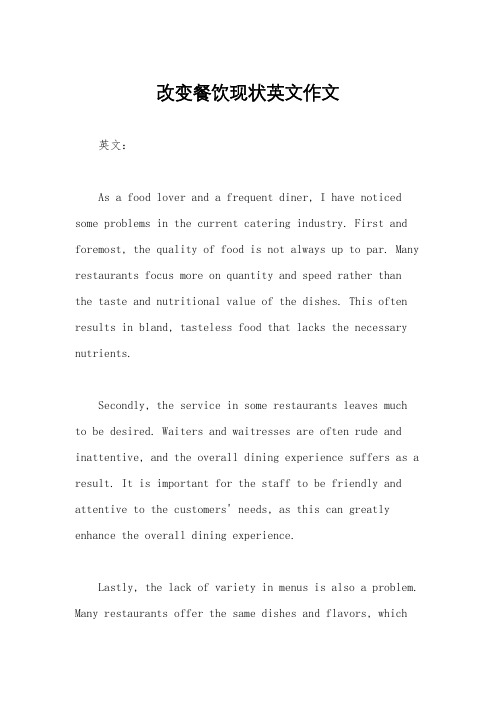
改变餐饮现状英文作文英文:As a food lover and a frequent diner, I have noticed some problems in the current catering industry. First and foremost, the quality of food is not always up to par. Many restaurants focus more on quantity and speed rather than the taste and nutritional value of the dishes. This often results in bland, tasteless food that lacks the necessary nutrients.Secondly, the service in some restaurants leaves much to be desired. Waiters and waitresses are often rude and inattentive, and the overall dining experience suffers as a result. It is important for the staff to be friendly and attentive to the customers' needs, as this can greatly enhance the overall dining experience.Lastly, the lack of variety in menus is also a problem. Many restaurants offer the same dishes and flavors, whichcan become boring and unappealing over time. It is important for restaurants to constantly update their menus and offer new and exciting dishes to keep customers coming back.To address these issues, I believe that restaurants should focus more on quality over quantity. Instead of trying to churn out as many dishes as possible, they should take the time to perfect each dish and ensure that it is both delicious and nutritious. Additionally, staff should be trained to be more friendly and attentive to customers, as this can greatly enhance the dining experience. Lastly, restaurants should make an effort to constantly updatetheir menus and offer new and exciting dishes to keep customers interested.中文:作为一位美食爱好者和常客,我注意到当前餐饮行业存在一些问题。
关于中国快餐业发展的英语作文
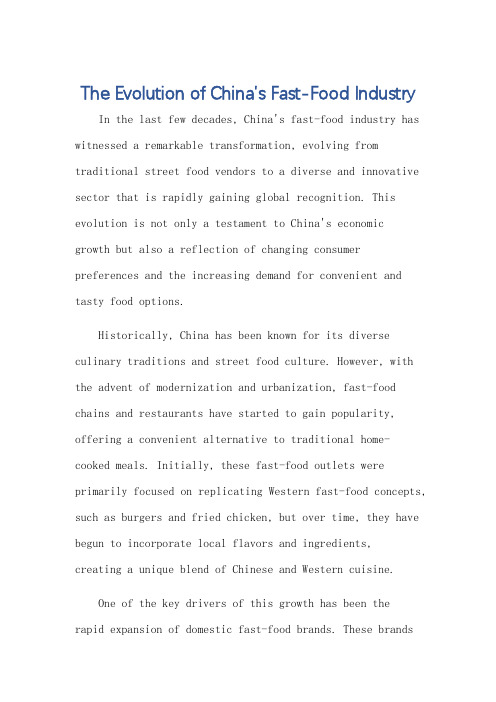
The Evolution of China's Fast-Food Industry In the last few decades, China's fast-food industry has witnessed a remarkable transformation, evolving from traditional street food vendors to a diverse and innovative sector that is rapidly gaining global recognition. This evolution is not only a testament to China's economicgrowth but also a reflection of changing consumer preferences and the increasing demand for convenient and tasty food options.Historically, China has been known for its diverse culinary traditions and street food culture. However, with the advent of modernization and urbanization, fast-food chains and restaurants have started to gain popularity, offering a convenient alternative to traditional home-cooked meals. Initially, these fast-food outlets were primarily focused on replicating Western fast-food concepts, such as burgers and fried chicken, but over time, they have begun to incorporate local flavors and ingredients,creating a unique blend of Chinese and Western cuisine.One of the key drivers of this growth has been therapid expansion of domestic fast-food brands. These brandshave capitalized on the country's vast consumer base and the increasing disposable income of the middle class. They have also invested heavily in improving their supply chain, ensuring the availability of fresh and high-quality ingredients. As a result, these brands have been able to offer a wide range of menu options that cater to the diverse tastes and preferences of Chinese consumers.Another significant trend in China's fast-food industry is the rise of digitalization and technology. The integration of mobile payment systems, online ordering platforms, and delivery services has made it easier for consumers to access fast-food options. This has not only increased the convenience factor but also expanded the reach of fast-food restaurants, allowing them to tap into new customer segments and markets.Moreover, the fast-food industry in China has also responded to the growing demand for healthier and more sustainable food options. Many brands have started to offer low-fat, low-calorie, and vegetarian menu items, as well as incorporating sustainable practices into their operations. This shift is not only aligned with global trends but alsoreflects the changing attitudes of Chinese consumers towards healthy eating and environmental sustainability.However, despite this remarkable growth, the Chinese fast-food industry still faces several challenges. One of the main challenges is the intense competition from both domestic and international brands. This competition has led to intense price wars and discounting, which can erode profits and hamper the long-term sustainability of businesses. Additionally, the industry also needs to address concerns about food safety and hygiene, which are paramount in ensuring consumer trust and loyalty.In conclusion, the evolution of China's fast-food industry has been remarkable, reflecting the country's economic growth and changing consumer preferences. With the integration of technology, healthier menu options, and sustainable practices, the industry has the potential to continue to grow and expand its reach globally. However, to achieve long-term success, brands must address the challenges of competition and food safety while continuing to innovate and meet the evolving needs of their customers. **中国快餐业的发展**在过去的几十年里,中国快餐业经历了显著的变革,从传统的街头食品小贩发展成为一个多样化和创新性的行业,并迅速获得全球认可。
我对我国饭店业发展的认识作文总结
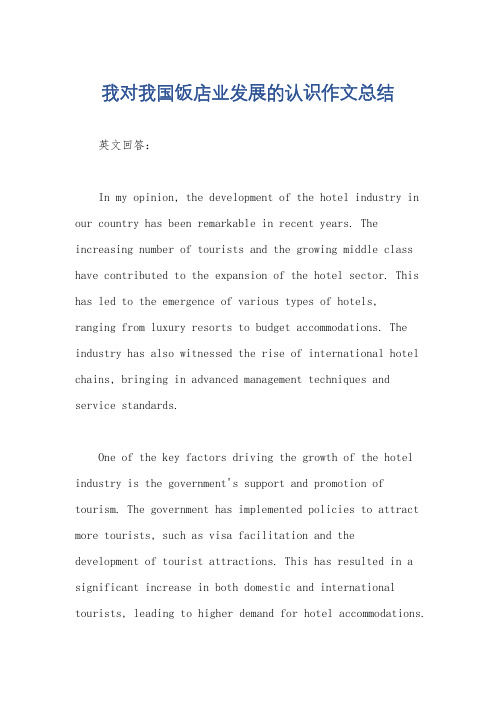
我对我国饭店业发展的认识作文总结英文回答:In my opinion, the development of the hotel industry in our country has been remarkable in recent years. The increasing number of tourists and the growing middle class have contributed to the expansion of the hotel sector. This has led to the emergence of various types of hotels,ranging from luxury resorts to budget accommodations. The industry has also witnessed the rise of international hotel chains, bringing in advanced management techniques and service standards.One of the key factors driving the growth of the hotel industry is the government's support and promotion of tourism. The government has implemented policies to attract more tourists, such as visa facilitation and the development of tourist attractions. This has resulted in a significant increase in both domestic and international tourists, leading to higher demand for hotel accommodations.Moreover, the improvement in living standards and disposable income of the middle class has also played a crucial role in the development of the hotel industry. With more people being able to afford travel and leisure activities, the demand for hotels has surged. This has encouraged hoteliers to invest in new properties and upgrade existing ones to cater to the needs of different types of travelers.Furthermore, the advancements in technology havegreatly influenced the hotel industry. The rise of online booking platforms and mobile applications has made it easier for travelers to find and book hotels. This has not only increased convenience for customers but also allowed hotels to reach a wider audience and maximize their occupancy rates. Additionally, hotels have embraced technology in their operations, such as using automated check-in systems and implementing smart room features, to enhance the overall guest experience.In terms of challenges, competition is a major concernfor the hotel industry. With the increasing number of hotels, each establishment needs to differentiate itself and provide unique experiences to attract customers. This requires continuous innovation and investment in facilities and services. Additionally, the rise of alternative accommodations, such as Airbnb, has posed a threat to traditional hotels. These platforms offer a different experience and often at a lower price, attracting a segment of travelers who prefer a more personalized and local stay.To address these challenges, hotels need to focus on providing exceptional customer service and creating memorable experiences. They should also leverage technology to streamline operations and improve efficiency. Moreover, collaboration with local communities and businesses can help hotels offer authentic experiences and support sustainable tourism.中文回答:在我看来,我国的饭店业发展近年来取得了显著的成就。
中国外卖行业发展英语作文
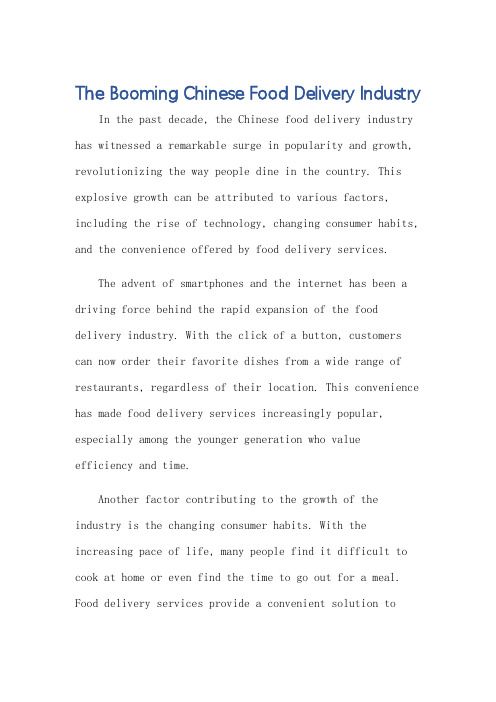
The Booming Chinese Food Delivery Industry In the past decade, the Chinese food delivery industry has witnessed a remarkable surge in popularity and growth, revolutionizing the way people dine in the country. This explosive growth can be attributed to various factors, including the rise of technology, changing consumer habits, and the convenience offered by food delivery services.The advent of smartphones and the internet has been a driving force behind the rapid expansion of the food delivery industry. With the click of a button, customers can now order their favorite dishes from a wide range of restaurants, regardless of their location. This convenience has made food delivery services increasingly popular, especially among the younger generation who valueefficiency and time.Another factor contributing to the growth of the industry is the changing consumer habits. With the increasing pace of life, many people find it difficult to cook at home or even find the time to go out for a meal. Food delivery services provide a convenient solution tothis problem, allowing people to enjoy a variety ofcuisines without leaving the comfort of their homes.Moreover, the food delivery industry has also benefited from the innovation and competition among various platforms. These platforms offer discounts, coupons, and loyalty programs to attract and retain customers. This has further fueled the growth of the industry by making food delivery more affordable and appealing to a wider audience.However, the booming food delivery industry has also faced some challenges. One of the main concerns is theissue of food safety and hygiene. With the increase in the number of delivery personnel and restaurants participatingin the food delivery ecosystem, ensuring food quality and safety has become a top priority. To address this issue, many food delivery platforms have implemented stricthygiene standards and food safety measures, such as temperature control and proper packaging, to ensure the quality of the delivered food.Despite these challenges, the Chinese food delivery industry continues to grow and evolve. With the increasing demand for convenient and affordable dining options, theindustry is expected to continue to expand in the future. In addition, the integration of advanced technologies such as artificial intelligence and machine learning is expected to further enhance the efficiency and customer experience of food delivery services.In conclusion, the Chinese food delivery industry has witnessed significant growth in recent years, driven by the rise of technology, changing consumer habits, and the convenience offered by delivery services. While challenges such as food safety and hygiene need to be addressed, the industry remains poised for continued growth and innovation in the future.**中国外卖行业的蓬勃发展**在过去的十年里,中国外卖行业经历了显著的增长和普及,彻底改变了国人的就餐方式。
中国服务业现状(英语)

Disadvantages of China's service industry
the development of the service sector mainly in the fields of tourism and the export of labor services. ocean transportation and natural resources, traditional advantage in laborintensive sectors, the world's largest trade finance, Insurance Advisory-mail and other technology-intensive and knowledge-intensive service industries in China is still in its initial stage of development. is a weak link and the development of other industries is very inappropriate.
telecommunications.
To the end of 1998, including mobile phones, the total number of telephone users in China has 110 million households. 10.64%,1998 telephone service, the telecommunications business income reached 229.5 billion yuan. become one of the pillars of the national economy.
中国外卖行业发展英语作文
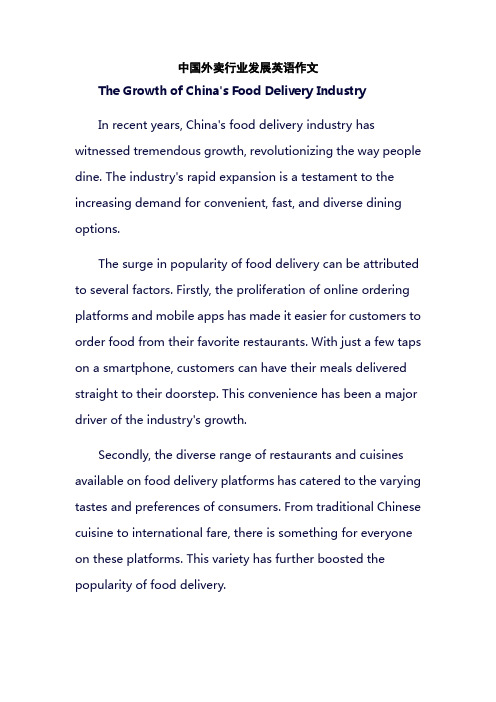
中国外卖行业发展英语作文The Growth of China's Food Delivery IndustryIn recent years, China's food delivery industry has witnessed tremendous growth, revolutionizing the way people dine. The industry's rapid expansion is a testament to the increasing demand for convenient, fast, and diverse dining options.The surge in popularity of food delivery can be attributed to several factors. Firstly, the proliferation of online ordering platforms and mobile apps has made it easier for customers to order food from their favorite restaurants. With just a few taps on a smartphone, customers can have their meals delivered straight to their doorstep. This convenience has been a major driver of the industry's growth.Secondly, the diverse range of restaurants and cuisines available on food delivery platforms has catered to the varying tastes and preferences of consumers. From traditional Chinese cuisine to international fare, there is something for everyone on these platforms. This variety has further boosted the popularity of food delivery.Moreover, the industry has also been driven by the increasing urbanization and busy lifestyles of Chinese consumers. With many people working long hours and leading hectic lives, food delivery has become a convenient and time-saving option for them.The growth of the food delivery industry has also had a positive impact on the economy. It has created numerous job opportunities, including delivery riders, restaurant staff, and technology personnel. Additionally, it has also boosted the sales of restaurants and food vendors, helping them to expand their customer base and increase revenue.Looking ahead, the food delivery industry in China is expected to continue to grow. With the development of technology, such as artificial intelligence and automation, the industry is likely to become even more efficient and convenient. Additionally, the increasing demand for healthy and nutritious food is also expected to drive the growth of healthy food delivery options.In conclusion, the food delivery industry in China has grown rapidly in recent years, driven by convenience, variety,and busy lifestyles. Its growth has had a positive impact on the economy and is expected to continue in the future.。
中国餐饮业的英语作文
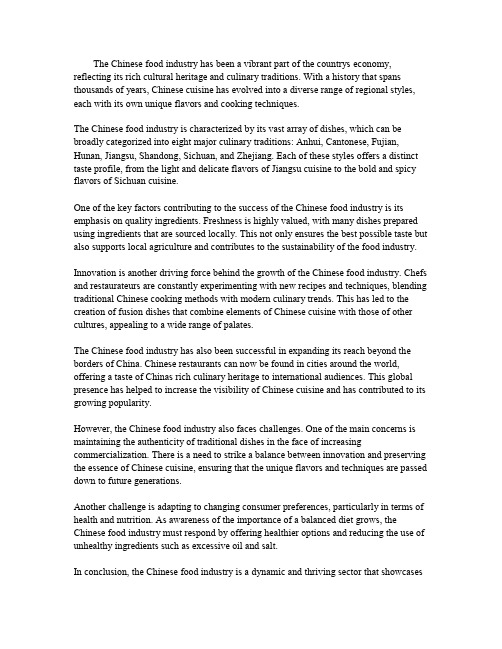
The Chinese food industry has been a vibrant part of the countrys economy, reflecting its rich cultural heritage and culinary traditions. With a history that spans thousands of years, Chinese cuisine has evolved into a diverse range of regional styles, each with its own unique flavors and cooking techniques.The Chinese food industry is characterized by its vast array of dishes, which can be broadly categorized into eight major culinary traditions: Anhui, Cantonese, Fujian, Hunan, Jiangsu, Shandong, Sichuan, and Zhejiang. Each of these styles offers a distinct taste profile, from the light and delicate flavors of Jiangsu cuisine to the bold and spicy flavors of Sichuan cuisine.One of the key factors contributing to the success of the Chinese food industry is its emphasis on quality ingredients. Freshness is highly valued, with many dishes prepared using ingredients that are sourced locally. This not only ensures the best possible taste but also supports local agriculture and contributes to the sustainability of the food industry.Innovation is another driving force behind the growth of the Chinese food industry. Chefs and restaurateurs are constantly experimenting with new recipes and techniques, blending traditional Chinese cooking methods with modern culinary trends. This has led to the creation of fusion dishes that combine elements of Chinese cuisine with those of other cultures, appealing to a wide range of palates.The Chinese food industry has also been successful in expanding its reach beyond the borders of China. Chinese restaurants can now be found in cities around the world, offering a taste of Chinas rich culinary heritage to international audiences. This global presence has helped to increase the visibility of Chinese cuisine and has contributed to its growing popularity.However, the Chinese food industry also faces challenges. One of the main concerns is maintaining the authenticity of traditional dishes in the face of increasing commercialization. There is a need to strike a balance between innovation and preserving the essence of Chinese cuisine, ensuring that the unique flavors and techniques are passed down to future generations.Another challenge is adapting to changing consumer preferences, particularly in terms of health and nutrition. As awareness of the importance of a balanced diet grows, the Chinese food industry must respond by offering healthier options and reducing the use of unhealthy ingredients such as excessive oil and salt.In conclusion, the Chinese food industry is a dynamic and thriving sector that showcasesthe countrys culinary diversity and creativity. By focusing on quality ingredients, innovation, and authenticity, while also addressing the challenges of globalization and health consciousness, the industry can continue to grow and flourish, delighting food lovers around the world with its delicious and diverse offerings.。
- 1、下载文档前请自行甄别文档内容的完整性,平台不提供额外的编辑、内容补充、找答案等附加服务。
- 2、"仅部分预览"的文档,不可在线预览部分如存在完整性等问题,可反馈申请退款(可完整预览的文档不适用该条件!)。
- 3、如文档侵犯您的权益,请联系客服反馈,我们会尽快为您处理(人工客服工作时间:9:00-18:30)。
现在越来越多的餐饮娱乐公司认识到,如果一个餐饮娱乐公司想要获得或保持竞争优势的话,战略规划和人力资源对其发展和前途都是最重要的,而且这两者必须紧密结合起来,因为战略规划的各个要素都包含人力资源因素,都必须获得人力资源的支持才能实现。
基于此,很多餐饮娱乐公司都请人力资源专家实质性的参与战略研究和制定全过程,从而实现战略与人力资源规划在战略规划和战略管理过程的早期就结合为一体。
这种变化趋势对于人力资源管理者来说也同样具有重要意义。
因为人力资源规划是衡量和评价人力资源对餐饮娱乐公司效益的贡献的基础,如果无法真正清楚餐饮娱乐公司的战略目标,不将人力资源发展与餐饮娱乐公司战略目标紧密联系起来,人力规划就是变得毫无意义。
因此,人力资源管理与餐饮娱乐公司战略规划的一体化从根本上提供了人力资源及人才资源管理对餐饮娱乐公司做出贡献的机会。
从事后管理向超前管理转变人力资源管理在知识经济时代已逐渐从事后移到事前,对客户、业务和市场有必要深入接触和了解,存此基础之上把握整个公司的走向和对整个行业的走势进行前瞻性预测,以实现人力资源的超前式管理。
九十年代以来,越来越多的餐饮娱乐公司实施了各种组织变革的计划,人多数人力资源经理成为这些变革计划的组织者和领导人。
在工作中,他们遇到的最有挑战性的问题是管理变革和再造工程。
近年来,他们的问题又变成了促进员工参与、改进客户服务、支持全面质量管理等方面的内容。
目前越来越多的餐饮娱乐公司的人力资源部门将工作重点放在提高生产力上,将事务性工作标准化、自动化,而对设计、实施各种有利于提高员工生产力和餐饮娱乐公司的整体绩效的方案投入更多的人力和物力,这又对人力资源管理部门的工作职责,人员素质提出了更高的要求。
这种趋势将继续发展下去,人力资源管理的职能将直指餐饮娱乐公司的使命。
人力资源活动的经济责任以及对餐饮娱乐公司绩效的贡献将得到普遍承认人力资源开发经历了五个发展阶段。
第一阶段是培训与发展,主二要研究培训员工的各种活动。
第二阶段是人力资源发展,包括培训与发展、组织发展以及员工生涯发展。
第三阶段是员工绩效提升,或者叫绩效咨询,对影响员工绩效的各个方面都予以关注,并致力于员工绩效的提高。
第四阶段是学习绩效,人力资源开发专家更加关注培训带来的收益,并将人力资源开发的关注点从培训转向以员工为主体的学习。
第五阶段是学习者,这是刚刚兴起的发展方面,人力资源专家致力于挖掘员工学习的动力,使员工成为更有效的学习者和知识消费者,使每个人都成为主动学习的人。
这五个发展阶段说明人力资源管理的职能已从过去的行政事务性管理上升到考虑如何开发餐饮娱乐公司人员的潜在能力,不断提高效率上来。
它更多地以经营者的眼光,注重餐饮娱乐公司在吸引人才、培养人才、激励人才等方面的投入,因为人力资本投资具有较高的、甚至无可比拟的回报率,是餐饮娱乐公司发展的最有前途的投资。
人力资源部门不再仅仅是个纯消费部门,而是能为餐饮娱乐公司带来经济效益的部门。
近年来,人们进行了许多经验性研究,试图找到人力资源活动效益与餐饮娱乐公司绩效之间的关系。
美国的一个研究机构考察了成熟的人力资源活动与生产力,人员流动率以及财会绩效标准之间的关系。
这项研究通过考察资本回报速率、股东收益率以及价格成本差额,证明适当的人力资源活动与提高餐饮娱乐公司绩效之间有强大的交互作用:适当的人力资源活动能降低人员流动率、提高员工人均销售额计算的生产力。
这个研究指出,人力资源活动是最后一个没有达到合理化的重大经营领域。
未来生产绩效收益将不会住新的财务和会计领域中找到,也不会在市场营销领域中找到,而只能在过去被忽略了的人力资源领域找到。
未来餐饮娱乐公司人力资源管理的方式将彻底改变唯有变化才是唯一不变的现象是信息时代的特征。
因此,人力资源管理的方式也必须是动态的、变化着的。
存90年代,计算机和数据处理技术的进步扩大了人力资源信息系统的作用。
这些进步使得各种规模、各种类型的餐饮娱乐公司的人力资源经理和工作人员都能利用计算机来开展日常管理工作,国际互动联网已成为餐饮娱乐公司发布和获得人力资源活动信息的主要渠道之一。
强有力的信息技术成为人力资源管理再造的媒介之一,正在和将要改变人力资源活动决策、管理及评估方式,使人们随时跟踪和监控人力资源活动对餐饮娱乐公司的贡献的愿望逐步成为现实,人力资源活动的经济效益越来越清晰可见了。
由于人力资源管理的核心职能被确定为提高生产力和餐饮娱乐公司的经营绩效,因而凡是有利于实现这个职能的工作方式部可以采用。
为了提高人力资源管理工作的效益和效率,同时降低工作成木,越来越多的餐饮娱乐公司,尤其是中小餐饮娱乐公司愿意利用人力资源管理顾问公司提供的服务,这就是所谓人力资源外包化趋势。
例如,猎头公司的工作是协助餐饮娱乐公司招募人力,他们精于人员的筛选、测试及面谈技巧,而且又拥有完整的人才数据库,在人才招募选拔方面的优势大于一般行业。
又如培训活动,即使一些自己拥有内部培训中心的餐饮娱乐公司,也需要借助社会上专门的培训机构或管理顾问机构,因为这些机构小仅有足够的师资、充分的信息、专业的培训技巧,还可以提供更为广泛的交流机会。
培训方案是培训目标、培训内容、培训指导者、受训者、培训日期和时间、培训场所与设备以及培训方法的有机结合。
培训需求分析是培训方案设计的指南,一份详尽的培训需求分析就大致构画出培训方案的大概轮廓,在前面培训需求分析的基础上,下面就培训方案各组成要素进行具体分析。
培训目标的设置培训目标的设置有赖于培训需求分析,在培训需求分析中我们讲到了组织分析、工作分析和个人分析,通过分析,我们明确了员工未来需要从事某个岗位,若要从事这个岗位的工作,现有员工的职能和预期职务之间存在一定的差距,消除这个差距就是我们的培训目标。
设置培训目标将为培训计划提供明确方向和依循的构架。
有了目标,才能确定培训对象、内容、时间、教师、方法等具体内容,并可在培训之后,对照此目标进行效果评估。
培训总目标是宏观上的、较抽象的,它需要不断分层次细化,使其具体化,具有可操作性。
要达到培训目标,就要求员工通过培训掌握一些知识和技能,即希望员工通过培训后了解什么?你希望员工通过培训后能够干什么?你希望员工通过培训后有哪些改变?这些期望都是以培训需求分析为基础的,通过需求分析,明了员工的现状,知道员工具有哪些知识和技能,具有什么样职务的职能,而餐饮娱乐公司具有什么样的知识和技能的员工,预期中的职务大于现有的职能,则要求培训。
明了员工的现有职能与预期中的职务要求二者之间的差距,即确定了培训目标,把培训目标进行细化,明确化,则转化为各层次的具体目标,目标越具体越具有可操作性,越有利于总体目标的实现。
培训内容的选择在明确了培训的目的和期望达到的学习结果后,接下来就需要确定培训中所应包括的传授信息了。
尽管具体的培训内容千差万别,但一般末说,培训内容包括三个层次,即知识培训、技能培训和素质培训,究竟该选择哪个层次的培训内容,应根据各个培训内容层次的特点和培训需求分析来选择。
谁来指导培训培训资源可分为内部资源和外部资源,内部资源包括组织的领导、具备特殊知识和技能的员工;外部资源是指专业培训人员、学校、公开研讨会或学术讲座等。
在众多的培训资源中,选择何种资源,最终要由培训内容及可利用的资源来决定。
外部资源和内部资源各有优缺点,但比较之下,还是首推内部培训资源,只有在组织业务确实繁忙,分不开人手时,或确实内部培训资源缺乏适当人选时,才可选择外部培训资源,但尽管如此,也要把外部资源与内部资源结合使用才为最佳。
确定受训者根据组织的培训需求分析,不同的需求决定不同的培训内容,从而大体上确定不同的培训对象,即受训者。
虽然培训内容决定了大体上的受训者,但并不等于说这些就是受训者,还应从确定的这些大体上的受训者的角度看其是否适合受训。
首先看这些人对培训是否感兴趣,若不感兴趣则不宜让其受训,因为没有积极性,效果肯定不会很好:另一方面,要看其个性特点,有些个性是天生的,既使通过培训能掌握所需的知识、技能,但他让然不适合于该工作,则他属于要换岗位,而不是需要培训。
从培训内容及受训行两方面考虑,最终确定受训者。
培训日期的选择培训日期的选择。
什么时候需要就什么时候培训,这道理显而易见,但事实上,做到这一点并不容易,却往往步入一些误区,下面的做法就是步入了误区。
许多公司往往是在时间比较方便或培训费用比较便宜的时候提供培训。
如许多公司把计划订在生产淡季防止影响生产,却不知因为未及时培训却造成了大量次品、废品或其他事故,代价更高,再如有些公司把培训订在培训费用比较便宜的时候,而此时其实并不需要培训,却不知任需要培训时进行再培训却需要会出再培训的成本。
在作培训需求分析时,确定需要培训哪些知识与技能,根据以往的经验,对这些知识与技能培训做出日程安排,看大致需要多少时间,以及培训真正见效所需的时间,从而推断培训提前期的长短,根据何时需用这些知识与技能及提前期,最终确定培训日期。
适当培训方法的选择组织培训的方法有多种,如讲授法、演示法、案例法、讨论法、视听法、角色扮演法等,各种培训方法都有其自身的优缺点,为了提高培训质量,达到培训目的,往往需要各种方法配合起来,灵活使用,下面着重分析讲授法、演示法、案例法三种常用方法。
在培训时可根据培训方式、培训内容、培训目的而择一或择多种配台使用。
培训场所及设备的选择培训内容及培训方法决定着培训场所及设备。
培训场所有教室、会议室、工作现场等,若以技能培训为内容,则决定了最适宜的场所为工作现场,因为培训内容的具体性要求信息传授的具体性,而许多工作设备是无法推进教室或会议室的。
培训设备则包括教材、笔记本、笔、模型,有的还需幻灯机、录相机等,不同的培训内容及培训方法最终确定了培训场所和设备。
员工培训是则培训目标和期望结果、培训内容、培训指导者、受训者、培训日期、培训方法和培训场所及设备的有机结合,达到目标和结果是根本目的之所在,其后各个组成部分都是以它为出发点的,经过权衡利弊,做出决策,制定出一个以培训目标和结果为指南的系统方案,而不能是各组成部分作分离处理而任意组合。
虽然一个系统的培训方案不一定为有效的培训方案,但一个有效的培训方案必须是系统考虑的培训方案。
培训方案的评估及完善从培训需求分析开始设计培训方案,从制定培训目标到培训方法的选择以最终制定了一个系统的培训方案,这并不意味着培训方案的设计工作已经完成,因为任何一个好的培训方案必是一个由制定→测评→修改→再测评→再修改……→实施的过程,只有不断测评、修改才能使培训方案甄于完善。
培训方案的测评从三个维度来考察。
从培训方案本身角度考察,将其细化为三个指标来进行:一、内容效度,确认培训方案的各组成部分是否合理、系统化,是从培训方案的本身来说的,分析其是否符合培训需求分析,各要素前后是否协调一致,是最优选择;二、反应效度,看受训者反应,受训者是否对此培训感兴趣,是否能满足受训者的需要,如果否,找出原因;三、学习效度,以此方案培训,看传授的信息是否能被受训者吸收,如果否,则要考虑到传授的方法以及受训者学习的特点等各个方面的因素来加以改进。
